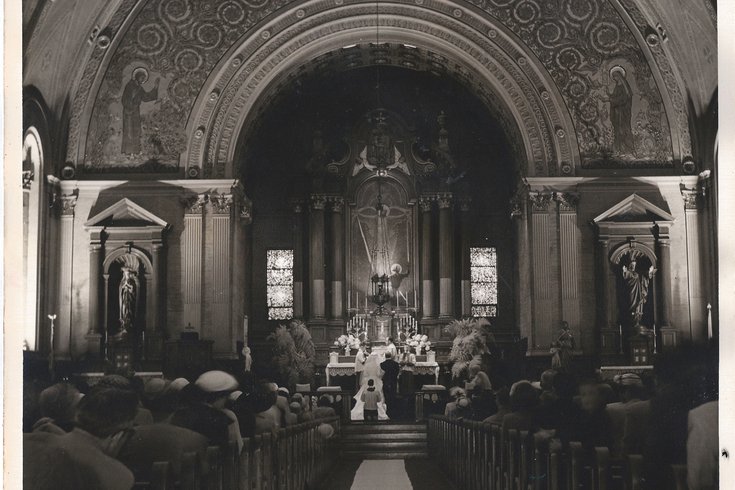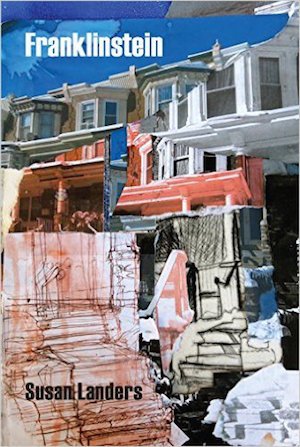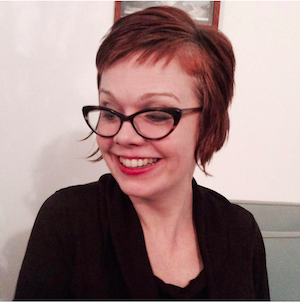
July 12, 2016
 Handout Art/Sue Landers
Handout Art/Sue Landers
A photo from Susan Landers' family collection of photos, depicting her parents getting married in a Germantown church.
In "Franklinstein," published this spring, Brooklynite Susan Landers journeys back to her childhood neighborhood of Germantown to learn both its origin story and what she calls the "making of a modern neighborhood" — a journey she then retells through her poetry.
"Franklinstein," at a breezy 135 pages, is part poetry collage and part pseudo-memoir that, in its first half, explains the book's origin story and weaves together a narrative of personal experiences growing up and the backstory of a neighborhood rich with history — a history of mills and churches and racism and transformed lots. She gets nostalgic at times, longing for a Catholic church torn down after its parishioners fled the neighborhood (herself included), but also ventures into tougher turf, recognizing the shades of yellow drawn onto street maps — ones that denoted the influx of what was then dubbed a "lower-grade population" — that would shape a neighborhood for a generation.
In its second half, Landers finds herself straddling the lines between historian, journalist and poet, and the book suffers when she tries to tackle too much — sometimes incorporating so many neighborhood stories at such a rapid clip that they struggle to make an impact. Other times, it's evident that her book began as an altogether different project that didn't quite develop into the cohesive product it could have been. Though, when at its best, it shines a light on the neighborhood's history, the prose doing a remarkable job of telling others' stories without losing their matter-of-factness or artistic integrity. Moreover, the book excels when it tackles poetry in a more essay-like form, making the read a more relatable experience for those who seldom (or never) touch down in Germantown.
"Franklinstein" gets more right than it doesn't: It's a well-researched look at the postwar era of a neighborhood seldom discussed by heavyweights, in which Landers ultimately comes to the right conclusion when she sums it up as "an old place and entirely new."
Below, Landers talks about how the book came to be, what she learned about her hometown and what everyone — in any neighborhood — should keep in mind when debating daily goings-on with neighbors.
You mention early on that this book began out with different concept which you later dismissed as ‘boring.’ How come?
When I first started writing this book, I literally set out to make a collage of these two seminal American texts, 'The Autobiography of Benjamin Franklin,' and Gertrude Stein’s 'Making of Americans,' and I was like ‘I’m literally going to take their language and drop it on a page and it’s going to be a monster called Franklinstein.' I did that for months, and as I was reading it through, editing, shaping it, it was just a failed experiment.
 Handout Art/for PhillyVoice
Handout Art/for PhillyVoice'Franklinstein'
You did keep the book title.
It still seems applicable because it’s this place that has this incredible amount of diversity and history layered on top of each other. It’s like a collage. And it’s a place misunderstood, like Dr. Frankenstein’s monster. Germantown is often misunderstood and mischaracterized and perceived in a much more negative light than it deserves to be.
You wrote, 'Sometimes what we come to know is what is lost after others don’t care to know it — this lot once a squat is coming to mean something about what records get recorded.' And you mention this in the context of talking about records on the internet — kind of this idea that if the internet doesn’t have a record of it, it’s not real. Do you think there's some truth to that?
I realized that Germantown, this place, was really complex. It wears all of its history on its sleeve. You hear the language of the Lenape in the Wissahickon and the street names are all [named after] these Revolutionary War generals.
That’s one way to see it. And when I started writing I think I was thinking of it like that. But interestingly, when I started, I live in Brooklyn, so from the very beginning — I did onsite research — but I was doing offsite research from the internet and wasn’t coming up with a lot of information. The Wikipedia page has changed in the time of my writing this, but at the time it pretty much went from this colonial history to demographics of today. And nothing in between. All these gaping holes — particularly in its 20th-century story. So at first I’m like, ‘Oh my God, this is not on the internet.’ And that was reinforcing my sense of it as a lost space. But then I started searching social media and I’d find artists living and working in the neighborhood — and activists — talking about it as a place today. I met a photographer, Tieshka Smith, who was doing street photography there, whose images are in the book; James Johnson who grew up there, who's now in West Philly, and another photographer, and then there are these community activists who live on one block and are committed to improving quality of life on that one block and constantly tweeting. So I was able to meet really important people to the book and Germantown, through social media. So I just had to adjust my approach to the internet. There’s still not a lot of information on Germantown on the internet, at large, but it did turn out to be more helpful than I thought it was going to be.
You also talk about men naming streets after men. Do you think that’s a Germantown- or Philly-specific thing?
No, streets are all around you and you don’t think about why they’re named that way, but once you start to explore most are named after men. [Laughs] Every city has this. You have your street names who are named after people who shaped or informed the city, and usually, those are people in power, and for a long time those [were men]. ‘So a street was named after a person. Why is it named after that person, what did this person do? What part of history is getting recorded at the expense of some other person in history not getting recorded?’ And it really made my understanding of the neighborhood kind of deeper and broader just in general. I look at historical markers now, street names, and think ‘Who is that guy?'
You structured the book in two parts with an interlude. Why’d you decide to arrange it that way?
 Handout Art/for PhillyVoice
Handout Art/for PhillyVoiceSue Landers, author of 'Franklinstein.'
After writing all the individual pieces I realized I also wanted to tell the story of how the book came to be in my own process. I realized at the end after writing all the poems ‘I need to write an essay.’ And so I wrote this essay that kind of documents the journey of writing it and it falls in two parts: the place I started from, with limited information and a place of misconception and perception, to where I landed which is what I hope is a more informed and responsible, deeper understanding.
What do you think is the challenge of conveying history through poetry?
There’s a lot of challenges there. First, being responsible — doing appropriate levels of research in order to get enough info that can then be transformed into poetry. Also recognizing that I am not a historian and have not been trained as a historian, I also embraced my inexpertise and the fact I am not an expert in historical research, and have a certain kind of creativity — but I never wanted it to be at the expense of a fact, or particularly at the expense of a person who was telling me something. So it was really balancing rigor and inexpertise and going in and out between those two paradigms.
So what did you learn about Germantown in the end that was surprising?
So much. I learned a lot about structural racism and how the neighborhood was shaped by both individual people’s decisions to move away or leave the neighborhood, versus actual federal and state law that either limited or afforded people mobility. I didn’t know any of that history. The security maps of the ’30s and the history of blockbusting and the history of racist property, real estate. I didn’t know any of that — I didn’t know about its kind of current rich artist community. I didn't know anything about them. That was really interesting. I learned it was this really complicated place. It’s not a place of abandoned buildings. It’s not this dangerous, low-income neighborhood. It’s much more complicated than that.
Why do you think so many poets herald from Germantown?
It’s a rich place, you know! It’s beautiful, it’s a wonderful place to live, there’s always artists there so you — you’d have to ask them why they live there, but it seems they get to be both poets and visual artists and historians, all these different genres and types of people coming together. Seems pretty neat. Yolanda [Wisher] is lovely. I did get to interview her. I never did get to meet Sonia [Sanchez], whose work is amazing. And Trapeta [Mayson] is incredible, as both a poet and head of Historic Germantown.
‘Pissy brick smell' is a description you use frequently in the book. What does that mean?
Think about the subway underpass. Concrete and urine. And mold. There are a bunch of alleys that had a moldy, pissy brick smell. And also the assonance of that 'I-I-I,’ it conjures up ‘Ick.’ It’s quite literal. [Laughs]
Why should people read this book?
Because there’s nothing else like it. I think people have connected to the book because it makes history accessible, poetry accessible. Germantown is a unique place but also an American story. So, think about migrations of people across America, how cities evolve. Germantown has experienced that firsthand. If you’re interested in urban planning, poetry, history, want to look at pictures, I think it has everything. It’s an accessible book. I found that when I read it people will come up to me afterward and tell me their life story. I think it inspires people to think about their own lives as members of communities and citizens and want to share, which is fantastic. It’s just so cool.
Anything to add? What’s it trying to say in the end, in a nutshell?
That history is complicated. That it’s important to get more information in order to have an informed perspective about the communities we live in. And the communities we either build or sustain or destroy. It’s helpful to understand where things come from.